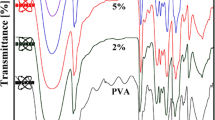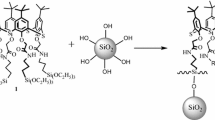Abstract
A post-polymerization method for metal–organic frameworks (MOFs) and silica nanoparticles have been developed to produce super-acidic solid nanoparticle. Thus, silica and amino-functionalized metal−organic framework [NH2-MIL-101(Al)] were functionalized with 4.4′-Azobis(4-cyanovaleric acid) (ACVA) from hydroxyl and amine groups to yield initiator anchored silica and MOF nanoparticles. Then, sulfonated polymer/MOF and sulfonated polymer/silica hybrid nanoparticles were prepared by free radical polymerization of 2-acrylamido-2-methyl-1-propane sulfonic acid [(MOF-g-PAMPS) and (Si-g-PAMPS)], initiated onto the surfaces of initiator functionalized nanoparticles. Synthesis and modification of nanoparticles were characterized by fourier transform infrared (FTIR), thermogravimetric analysis (TGA). Also, the attachment of ACVA modifier agent on the surface of silica nanoparticles was studied using X-ray photoelectron spectroscopy (XPS). FTIR and TGA results indicated that AMPS monomer was successfully grafted onto the MOF and silica nanoparticles. The grafting efficiency of PAMPS polymer onto the silica and MOF nanoparticles were estimated from TGA thermograms to be 17 and 35 % for silica and MOF nanoparticles, respectively. Morphology of MOF and silica nanoparticles before and after modification processes were studied by scanning electron microscopy (SEM) and transmission electron microscopy (TEM), respectively.








Similar content being viewed by others
References
Laberty-Robert C, Valle K, Pereira F, Sanchez C (2011) Design and properties of functional hybrid organic–inorganic membranes for fuel cells. Chem Soc Rev 40:961–1005
Nagarale RK, Shin W, Singh PK (2010) Progress in ionic organic–inorganic composite membranes for fuel cell applications. Polym Chem 1:388–408
Peighambardoust SJ, Rowshanzamir S, Amjadi M (2010) Review of the proton exchange membranes for fuel cell applications. Int J Hydrog Energy 35:9349–9384
Smitha B, Sridhar S, Khan AA (2005) Solid polymer electrolyte membranes for fuel cell applications-a review. J Membr Sci 259:10–26
Kalappa P, Lee JH (2007) Proton conducting membranes based on sulfonated poly(ether ether ketone)/TiO2 nanocomposites for a direct methanol fuel cell. Polym Int 56:371–375
Suryani CCM, Liu YL, Lee YM (2011) Polybenzimidazole membranes modified with polyelectrolyte-functionalized multiwalled carbon nanotubes for proton exchange membrane fuel cells. J Mater Chem 21:7480–7486
Chu F, Lin B, Qiu B, Si Z, Qiu L, Gu Z, Ding J, Yan F, Lu J (2012) Polybenzimidazole/zwitterion-coated silica nanoparticle hybrid proton conducting membranes for anhydrous proton exchange membrane application. J Mater Chem 22:18411–18417
Gosalawit R, Chirachanchai S, Shishatskiy S, Nunesb SP (2008) Sulfonated montmorillonite/sulfonated poly(ether ether ketone) (SMMT/SPEEK) nanocomposite membrane for direct methanol fuel cells (DMFCs). J Membr Sci 323:337–346
Cao YC, Xu C, Wu X, Wang X, Xing L, Scott K (2011) A poly (ethylene oxide)/graphene oxide electrolyte membrane for low temperature polymer fuel cells. J Power Sources 196:8377–8382
Kitagawa S, Kitaura R, Si N (2004) Functional porous coordination polymers. Angew Chem Int Ed 43:2334–2375
Chen G, Wu S, Liu H, Jiang H, Li Y (2013) Palladium supported on an acidic metal–organic framework as an efficient catalyst in selective aerobic oxidation of alcohols. Green Chem 15:230–235
Xiao B, Yuan Q (2009) Nanoporous metal organic framework materials for hydrogen storage. Particuology 7:129–140
Tanh Jeazet HB, Staudt C, Janiak C (2012) Metal–organic frameworks in mixed-matrix membranes for gas separation. Dalton Trans 41:14003–14027
Hwa Jhung BS, Lee JH, Yoon JW, Serre C, Férey G, Chang JS (2007) Microwave synthesis of chromium terephthalate MIL-101 and its benzene sorption ability. Adv Mater 19:121–124
Hurd JA, Vaidhyanathan R, Thangadurai V, Ratcliffe CI, Moudrakovski GL, Shimizu George KH (2009) Anhydrous proton conduction at 150 °Cin a crystalline metal–organic framework. Nat Chem 1:705–710
Kitagawa H (2009) Metal–organic frameworks transported into fuel cells. Nat Chem 1:689–690
Zheng GL, Yang GC, Song SY, Songa XZ, Zhang HJ (2014) Constructing porous MOF based on the assembly of layer framework and p-sulfonatocalix[4]arene nanocapsule with proton-conductive property. CrystEngComm 16:64–68
Foo ML, Horike S, Fukushima T, Hijikata Y, Kubota Y, Takataf M, Kitagawa S (2012) Ligand-based solid solution approach to stabilisation of sulphonic acid groups in porous coordination polymer Zr6O4(OH)4(BDC)6 (UiO-66). Dalton Trans 41:13791–13794
Goesten MG, Juan-Alcañiz J, Ramos-Fernandez EV, Sankar Gupta KBS, Eli S, Bekkum H, Gascon J, Kapteijn F (2011) Sulfation of metal–organic frameworks: opportunities for acid catalysis and proton conductivity. J Catal 281:177–187
Smith JJ, Zharov I (2009) Preparation and proton conductivity of sulfonated polymer-modified sintered and self-assembled silica colloidal crystals. Chem Mater 21:2013–2019
Brozek EM, Mollard AH, Zharov I (2014) Silica nanoparticles carrying boron-containing polymer brushes. J Nanoparticle Res 16:2407–2418
Roghani-Mamaqani H, Haddadi-Asl V, Khezri K, Zeinali E, Salami-Kalajahi M (2014) In situ atom transfer radical polymerization of styrene to in-plane functionalize graphene nanolayers: grafting through hydroxyl groups. J Polym Res 21:333–343
Gao B, Li D, Lei Q (2011) Preparation of high PMMA grafted particle SiO2 using surface initiated free radical polymerization. J Polym Res 18:1519–1526
Gao B, Fang L, Wang X, Men J (2012) Constituting redox initiation system of mercapto-cerium salt and realizing highly effective graft-polymerization of MAA on surfaces of silica gel particles. J Polym Res 19:4–13
Ahmadian-Alam L, Haddadi-Asl V, Roghani-Mamaqani H, Hatami L, Salami-Kalajahi M (2012) Use of clay-anchored reactive modifier for the synthesis of poly (styrene-co-butyl acrylate)/clay nanocomposite via in situ AGET ATRP. J Polym Res 19:9773–9784
Deng Y, Li Y, Dai J, Lang M, Huang X (2011) An efficient way to functionalize graphene sheets with presynthesized polymer via ATNRC chemistry. J Polym Sci A Polym Chem 49:1582–1590
Lei Z, Li Y, Wei X (2008) A facile two-step modifying process for preparation of poly(SStNa)-grafted Fe3O4/SiO2 particles. J Solid State Chem 181:480–486
Perruchot C, Khan MA, Kamitsi A, Armes SP (2001) Synthesis of well-defined, polymer-grafted silica particles by aqueous ATRP. Langmuir 17:4479–4481
Bromberg L, Su X, Hatton TA (2013) Heteropolyacid-functionalized aluminum 2‑aminoterephthalate metal-organic frameworks as reactive aldehyde sorbents and catalysts. ACS Appl Mater Interfaces 5:5468–5477
Feng L, Ye J, Qiang X, Zhang H (2011) Syntheses of an Azo-group-bound silica initiator and silica–polystyrene composites. J Appl Polym Sci 121:454–461
Salarizadeh P, Abdollahi M, Javanbakht M (2012) Modification of silica nanoparticles with hydrophilic sulfonated polymers by using surface-initiated redox polymerization. Iran Polym J 21:661–668
Park J, Seo J, Ahn S, Kim J, Kang S (2010) Surface modification of silica nanoparticles with hydrophilic polymers. J Ind Eng Chem 16:517–522
Laruelle G, Parvole J, Francois J, Billon L (2004) Block copolymer grafted-silica particles: a core/double shell hybrid inorganic/organic material. Polymer 45:5013–5020
Le Normand F, Hommet J, Szörényi T, Fuchs C, Fogarassy E (2001) XPS study of pulsed laser deposited CNx films. Phys Rev B 64:235416–235427
Sun W, Chen Y, Zhou L, He X (2006) Preparing polymer brushes on poly(vinylidene fluoride) films by free radical polymerization. J Appl Polym Sci 101:857–862
Tang E, Fu C, Wang S, Dong S, Zhao F, Zhao D (2012) Graft polymerization of styrene monomer initiated by azobis(4-cyanovaleric acid) anchored on the surface of ZnO nanoparticles and its PVC composite film. Powder Technol 218:5–10
Haque E, Lo V, Minett AI, Harris AT, Church TL (2014) Dichotomous adsorption behavior of dyes on an amino-functionalised metal–organic framework, amino-MIL-101(Al). J Mater Chem A 2:193–203
Seoane B, Téllez C, Coronas J, Staudt C (2013) NH2-MIL-53(Al) andNH2-MIL-101(Al) in sulfur-containing copolyimide mixed matrix membranes for gas separation. Sep Purif Technol 111:72–81
Chen X, Vinh-Thang H, Rodrigue D, Kaliaguine S (2012) Amine-functionalized MIL-53 metal − organic framework in polyimide mixed matrix membranes for CO2/CH4 separation. Ind Eng Chem Res 51:6895–6906
Bao Y, Ma J, Li N (2011) Synthesis and swelling behaviors of sodium carboxymethyl cellulose-g-poly(AA-co-AM-co-AMPS)/MMT superabsorbent hydrogel. Carbohydr Polym 84:76–82
Sarac AS (1999) Redox polymerization. Prog Polym Sci 24:1149–1204
Bombalski L, Min K, Dong H, Tang C, Matyjaszewski K (2007) Preparation of well-defined hybrid materials by ATRP in mini-emulsion. Macromolecules 40:7429–7432
Author information
Authors and Affiliations
Corresponding author
Rights and permissions
About this article
Cite this article
Mahdavi, H., Ahmadian-Alam, L. 32.Sulfonic acid functionalization of 2-aminoterephthalate metal−organic framework and silica nanoparticles by surface initiated radical polymerization: as proton-conducting solid electrolytes. J Polym Res 22, 67 (2015). https://doi.org/10.1007/s10965-015-0708-4
Received:
Accepted:
Published:
DOI: https://doi.org/10.1007/s10965-015-0708-4




